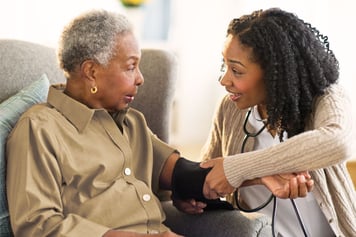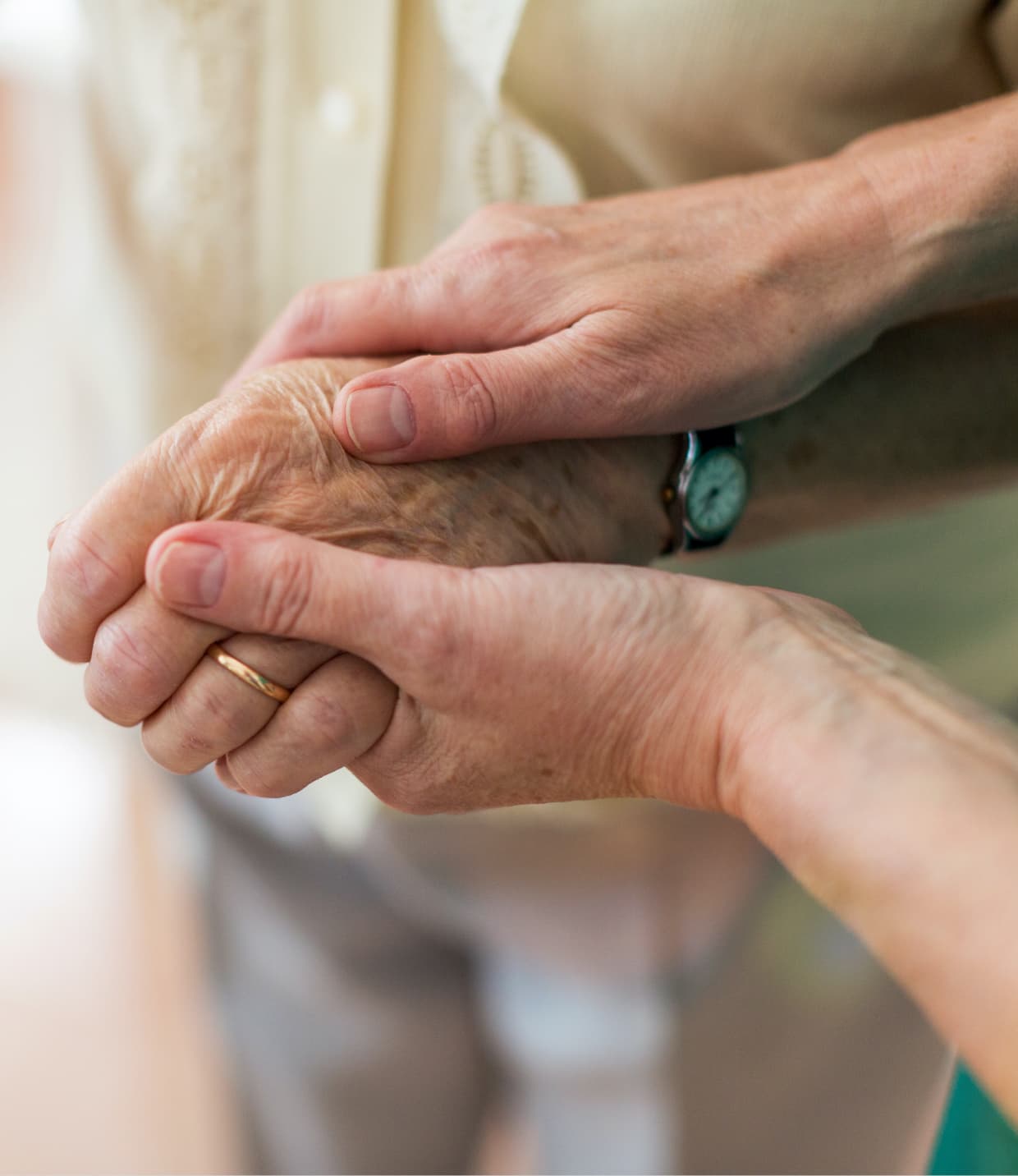When chronic obstructive pulmonary disease (COPD) progresses to its final stages, patients and their loved ones face difficult decisions about care options. Understanding the nuances of hospice care, how it can provide comfort and dignity to patients and how it can specifically treat COPD symptoms is crucial for making informed decisions about next steps.
What is End-Stage COPD?
COPD is a long-term, progressive lung condition that makes it hard to move air in and out of the lungs. Chronic bronchitis and emphysema are two of the most common conditions contributing to this disease, often occurring together and varying in severity among COPD patients.
COPD progresses gradually through four distinct stages [1], though some patients may experience rapid decline following acute exacerbations or hospitalizations:
- Stage 1 (Mild): Slight airflow limitation with minimal symptoms
- Stage 2 (Moderate): Worsening airflow limitation with increased breathlessness
- Stage 3 (Severe): Further deterioration with significant impact on quality of life
- Stage 4 (End-Stage): Very severe airflow limitation affecting daily activities and survival.
End-stage COPD, or Stage 4, represents the most advanced form of the disease. At this stage, the lungs have been significantly damaged, making breathing very difficult even during rest. The Global Initiative for Chronic Obstructive Lung Disease (GOLD) classification system defines end-stage COPD as having a forced expiratory volume (FEV1) of less than 30% of predicted normal values. [2]
.jpg?width=658&height=370&name=Blog%20Graphic%20Callouts%20(8).jpg)
Common Symptoms and Complications in End-Stage COPD
Patients with end-stage COPD can experience a range of symptoms and complications. [3] Respiratory symptoms include:
- Severe shortness of breath, or dyspnea, even at rest
- Chronic, productive cough
- Wheezing or whistling sounds
- Frequent respiratory infections
- An inability to lie flat due to breathing difficulties
Patients can also experience systemic and advanced complications, including:
- Chronic fatigue and weakness
- Significant weight loss
- Muscle atrophy
- Swelling in legs and ankles (peripheral edema)
- Cognitive changes due to reduced oxygen levels
- Anxiety and depression related to breathing difficulties
- Respiratory failure requiring mechanical ventilation
- Cor pulmonale (right heart failure)
- Frequent hospitalizations for COPD exacerbations
Hospice Eligibility for COPD Patients
Patients must meet three core eligibility criteria to receive hospice care under Medicare – their doctor has given a prognosis of six months or less to live, they have elected to forgo curative treatments for comfort measures and they choose a Medicare-approved agency for care.
.jpg?width=636&height=424&name=Website%20Photos%20(16).jpg)
Clinically speaking, providers look at the following criteria in evaluating COPD patients for hospice care:
- Disabling shortness of breath at rest, poorly responding to bronchodilators or other measures to improve breathing
- Increasing ER visits, physician office visits or hospitalizations for pulmonary infections or respiratory failure
- Hypoxemia (decreased oxygen levels) at rest, on room air
- Unintentional, progressive weight loss of more than 10% of body weight over the past six months
How Hospice Cares for COPD Patients at the End of Life
Hospice care is uniquely equipped to support COPD patients during the final stage of the disease, focusing on comfort, dignity and relief from distressing symptoms.
Symptom and Pain Management Through Medication
One of the central goals of hospice care is symptom and pain management. Hospice teams use a combination of medications tailored to each patient’s needs to relieve symptoms and provide as much comfort as possible, in consultation with the physician. Common medications include:
- Opioids: Low doses of opioids, like morphine, can be used to reduce the sensation of breathlessness, which is one of the most debilitating symptoms of the disease. These medications can help the brain interpret breathlessness less intensely, making it easier for patients to relax and breathe.
- Anxiolytics, like lorazepam: Shortness of breath often causes or worsens anxiety. These medications may be used alongside opioids to relieve panic or restlessness related to breathing difficulties.
- Bronchodilators and corticosteroids: Inhaled medications like albuterol and steroids may continue to be used in hospice to open airways and reduce inflammation, depending on the patient’s comfort and response.
- Anticholinergics, like scopolamine or atropine drops: These can help manage secretions, which can cause gurgling or choking during end-of-life breathing.
- Cough suppressants: These are used for persistent, distressing coughs.
- Oxygen therapy: Supplemental oxygen can reduce breathlessness and improve oxygen saturation levels. While it doesn’t always eliminate symptoms, it can be soothing for many patients.
Non-Medication Approaches to Comfort
While medications play a critical role in managing end-stage COPD symptoms, hospice teams can also employ a variety of non-pharmacologic strategies to enhance comfort:
- Fan therapy or cool air: A fan blowing gently across the face can trigger the trigeminal nerve and help reduce the sensation of breathlessness, offering relief.
- Positioning techniques: Elevating the head of the bed or encouraging patients to sit in a forward-leaning position can ease breathing.
- Energy conservation: Hospice aides work with patients and families to reduce the energy demands of daily activities, helping patients avoid unnecessary exertion that can exacerbate symptoms.
- Breathing techniques: Techniques like pursed-lip breathing can help COPD patients slow their breathing rate and reduce air trapping.
- Nutritional support: Many patients with advanced COPD experience unintentional weight loss and fatigue. Dietitians may recommend high-calorie, nutrient dense meals in small portions to meet energy needs without overexertion.
Emotional and Psychosocial Support
Hospice care is a holistic service, caring for all elements of a patient’s well-being. The full interdisciplinary team includes chaplains for spiritual care, medical social workers for counseling and bereavement counselors for the family after the patient’s passing.
Caring for a loved one with advanced COPD can be particularly draining, and hospice care works to support patients’ caregivers as well, providing respite care in certain situations, caregiver training and 24/7 phone support.
Hospice teams can also help patients and families with advance care planning to make clear, values-based decisions about care preferences, including the use of oxygen, antibiotics or resuscitation efforts.
Hospice also works to empower family caregivers with education on what to expect during the final stages of COPD and the patient’s life. They’re taught to recognize signs of distress, use medications, position the patient for comfort and provide emotional support.
Is Hospice Care the Answer?
One of the most difficult questions for patients and families is knowing when to consider hospice. While each case is unique, consider the following signs for COPD patients that may indicate hospice is appropriate:
- Frequent hospitalizations or emergency room visits
- Increased dependence on oxygen
- Severe shortness of breath at rest
- Difficulty with basic daily activities
- Unintentional weight loss
- A desire to focus more on quality of life than curative treatments
Hospice care can bring relief and dignity to patients living with end-stage COPD. It addresses not only the physical symptoms, but also the emotional, spiritual and psychosocial needs of the patient and the family. Early involvement with hospice allows patients to benefit fully from the support and expertise of a compassionate, multidisciplinary team focused on comfort and peace at the end of life.
If your loved one is experiencing end-stage COPD, consider taking our free hospice care assessment or complete the form at the bottom of this page to speak to a hospice specialist near you.
Deb Gallaher, MBA, MSN, RN, NE-BC, CHPN, is a Senior Hospice Clinical Education Specialist for Amedisys. She has 10 years of experience in hospice and is passionate about sharing her insights on high-quality care.
References |





